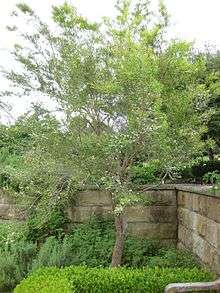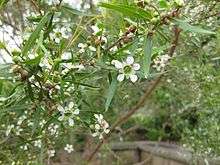Leptospermum petersonii
| Leptospermum petersonii | |
|---|---|
 | |
| Scientific classification | |
| Kingdom: | Plantae |
| Clade: | Angiosperms |
| Clade: | Eudicots |
| Clade: | Rosids |
| Order: | Myrtales |
| Family: | Myrtaceae |
| Genus: | Leptospermum |
| Species: | L. petersonii |
| Binomial name | |
| Leptospermum petersonii Bailey | |
Leptospermum petersonii (or Leptospermum citratum), lemon-scented teatree is a tall shrub to small tree, growing to a maximum of 5 metres which is cultivated as an ornamental and for essential oils. It naturally occurs near sclerophyll forest or rainforest, on sandy or rocky escarpments, on the east coast of Australia. It has simple leaves, 20–40 mm long, with a distinctive lemony aroma. The flowers are white, followed by woody capsules.
Uses
The leaves are distilled commercially for the essential oil which contains citronellal, citral, and pinene. It is grown in plantations in Kenya, Zaire, South Africa, Guatemala and Australia.
The leaf of lemon-scented teatree is also used as a flavouring ingredient in boutique tea blends with standard black tea, Camellia sinensis.
The essential oil from L.petersonii inhibits the pathological fungi Candida albicans and Aspergillus fumigatus.[1]
It can be mistaken for Backhousia citriodora (lemon myrtle).[2]
Cultivation

Lemon-scented teatree is well known as a garden plant, popular for its scent and attractiveness. It is fast growing and can be kept to shrub height by pruning. The ability to be pruned regularly also makes it well-suited for hedges, windbreaks and harvesting for distilled essential oils.[3]
Leptospermum liversidgei is also called "lemon-scented teatree" due to the presence of lemony essential oils.
References
- ↑ Hood JR, Burton DM, Wilkinson JM, Cavanagh HM., 2010, "The effect of Leptospermum petersonii essential oil on Candida albicans and Aspergillus fumigatus." Medical Mycology Nov;48(7):922-31
- ↑ Horn, Thomas; Barth, Anna; Rühle, Michael; Häser, Annette; Jürges, Gabriele; Nick, Peter (29 February 2012). "Molecular diagnostics of Lemon Myrtle (Backhousia citriodora versus Leptospermum citratum)". European Food Research and Technology. 234 (5): 853–861. doi:10.1007/s00217-012-1688-9.
- ↑ Cribb, A.B. & J.W., Useful Wild Plants in Australia, Collins 1982, p29 ISBN 0-00-636397-0
- Harden, G.J., Flora of New South Wales, Volume 2, ISBN 0-86840-164-1.